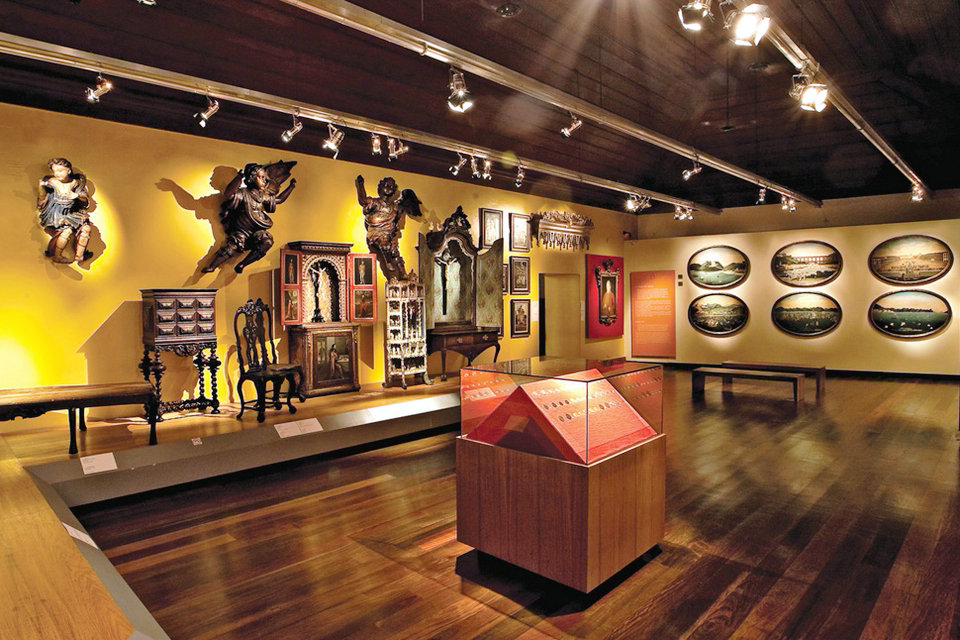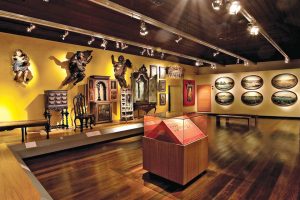It presents since the Portuguese maritime expansion, its causes and consequences, mainly the colonization of Brazil, until the proclamation of Independence by D. Pedro I.
It covers: the period of the Iberian Union, with Portugal and Spain governed by the Spanish Crown; the French and Dutch presence in the 16th and 17th centuries; the territorial expansion of the colony; the exploration of gold and diamonds in Minas Gerais and its reflection in the Baroque aesthetic; the cultural contribution of black Africans and their descendants in the Brazilian historical formation; the changes that took place in Rio de Janeiro and Brazil since the arrival of D. João in 1808, and the causes that led to the proclamation of independence.
Multimedia with the Portuguese navigation routes (1415 to 1557) and the “Carta de Caminha”, narrated by Paulo Autran, dynamize the exhibition. Among the pieces of collection, the “Índio” coin, a unique example in the world, minted in silver during the reign of D. Manuel I (1495-1521).
Portugal in Brazil
The Portuguese maritime expansion, its causes and consequences, and the colonization of Brazil until the proclamation of independence are shown at long term exhibition.
The Portuguese sea voyages and their achievements are presented at the exhibition.The presence of the Portuguese in Brazilian lands is recorded through various objects.
To talk about the colonization of Brazil, the museum shows an animated model of a sugar mill and the shape that gave its name to the traditional tourist spot in Rio de Janeiro, Pão de Açúcar (Sugarloaf Mountain)
Between 1580 and 1640 Portugal and Spain formed the Iberian Union, result of the dynastic union of the thrones of the two countries. It was a period of invasions in Brazilian territory, especially by French and Dutch.
Riches of Brazil. The “santa do pau-oco” (hollowed out saint carving), used to trade gold and precious stones, ores, and even oil, the country’s great source of wealth, are remembered in this part of the exhibition.
The exploration of gold also resulted in the emergence of artists such as Antônio Francisco Lisboa, also known as Aleijadinho.
Highlights
Descobrimento do Brasil
by Aurélio de Figueiredo
Pedro Álvares Cabral arrived in Brazil in 1500, inaugurating a new historical stage of our territory.
Moeda “O Índio”
by José Caldas
Portuguese coin minted in silver in 1499. It is called “O Índio” and is one of the only copies in the world.
Astrolábio
by José Caldas
Navigation instrument created by the Portuguese in the 15th century to measure the height of the stars above the horizon, the main reference point for navigation on the high seas.
[Ex-voto da] Batalha dos Guararapes
by Desconhecido
The Battle of Guararapes was one of the greatest conflicts in the colonial period. There were two clashes (between 1648 and 1649) between the Dutch and Portuguese-Brazilian armies at Morro dos Guararapes, the current municipality of Jaboatão dos Guararapes, in the metropolitan region of Recife (PE).
Resposta de Tiradentes à comutação da pena
by Leopoldino de Faria
The mining economy boosted Brazilian development, but the abusive and arbitrary fiscal control exercised by the Portuguese Crown gave rise to various revolt movements. Inconfidência Mineira became a symbol of the metropolis’ resistance to power.
Casa dos Contos
by Hans Nobauer
The residence of João Rodrigues de Macedo, tax administrator of the captaincy of Minas Gerais, served as administrative office for activities related to the exploration of gold. It was imprisonment of the inconfidentes and in 1792 it became the House of the Tales, property of the Portuguese Real Estate, being the headquarters of the administration and public accounting of the Captaincy of Minas Gerais. Today it houses a museum that preserves the history of the gold cycle.
Ovais de Leandro Joaquim
by José Caldas
Aspects of the city of Rio de Janeiro were portrayed in paintings attributed to the artist Leandro Joaquim, in the famous series known as “ovals.”
Igreja e Praia da Glória
by Leandro Joaquim
Oil on canvas attributed to Leandro Joaquim, entitled “Church and Praia da Glória,” measuring 96.50 cm in height and 126.50 cm in diameter. Oil on canvas attributed to Leandro Joaquim, entitled “Whaling in the Rio de Janeiro Bay,” measuring 96 cm in height and 125.7 cm in width.
Embarque do Príncipe Regente para o Brasil
by Nicolas-Louis-Albert Delerive
The coming of the Royal Family to Brazil in 1808 provoked a series of changes in relations between the two countries. The presence of the Portuguese court definitively modified the history of the then colony.
[Retrato de] D. João VI e D. Carlota Joaquina
by Manuel Dias de Oliveira
D. João and D. Carlota Joaquina became monarchs of the United Kingdom of Portugal, Brazil and the Algarves in 1816. The reign of King João VI left a lasting mark in nineteenth-century Brazil through the creation of a political and social structure which culminated in the independence of the country.
Barco
by Desconhecido
Rope toy representing a floating palace. It was presented by the Chinese government to Dom Pedro I when he was only five years old.
Tabuleiro de Xadrez
by Desconhecido
Chess game that belonged to D. Pedro I.
[Retrato de] D. Pedro I
by Manuel José de Araújo Porto-Alegre
D. Pedro became the first emperor of Brazil after the proclamation of independence in 1822. His government faced crises but made possible the construction of the nation he bequeathed to his son, D. Pedro II.
From the cave to the 21st century
The Exhibition Circuit starts on the ground floor, in the escalator hall, with panels telling the story of the architectural ensemble. Highlight for the equestrian sculpture of D. Pedro II, by Francisco Manoel Chaves Pinheiro. In the hall on the second floor, there is access to the gallery with a ceiling decorated by Carlos Oswald, where the multivision is projected on the trajectory of the National Historical Museum. After the exhibition, exhibitions present the history of Brazil: traditional collection, contemporary pieces and multimedia resources help the visitor to understand the history.
National History Museum of Brazil
The National Historical Museum of Brazil was created in 1922, and possesses over 287,000 items, including the largest numismatic collection of Latin America. The architectural complex that houses the museum was built in 1603 as the St. James of Mercy Fort; earlier structures date back to 1567, erected by order of King Sebastian I of Portugal. In 1693, the Calaboose Prison, for slaves, was built. In 1762, the Casa do Trem was added as a depot of weapons and ammunition. The last additions are the War Arsenal (1764) and the Barracks (1835).
The formation of the collection of the National Historical Museum began with the transfer of items from other institutions that already existed at the time of its foundation. Several items and pieces came from the National Archives museum and from the National Library’s numismatics office. The Casa da Moeda, the National Museum of Fine Arts, the Ministry of the Army and the Ministry of the Navy also contributed to the initial formation of the collection.
Currently, the National Historical Museum occupies the entire architectural complex of Ponta do Calabouço and became the most important museum of history in the country, bringing together a collection of 258,000 items, including objects, documents and books, and being an institution of production and dissemination of knowledge.
National Historical Museum maintains long-term and temporary exhibition galleries in a 9,000 m² area open to the public, as well as a library specialized in Brazil History, Art History, Museology and Fashion, and the Historical Archive with important manuscript documents, watercolors, illustrations and photographs, including Juan Gutierrez, Augusto Malta and Marc Ferrez.
It also maintains programs to students, teachers, senior citizens and poor communities. Its storage rooms, conservation and restoration laboratories and numismatics (collection of coins and other printed figures) can be consulted by prior appointment. Picturesque inner courtyards and a friendly cafeteria offer pleasant options for relaxing moments.






